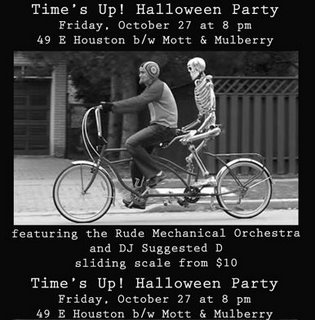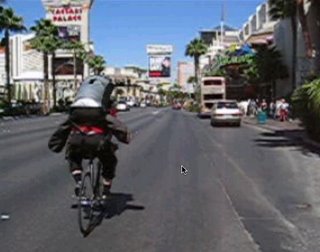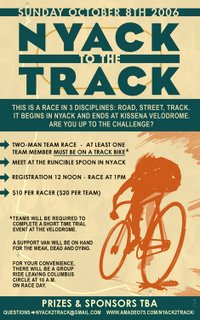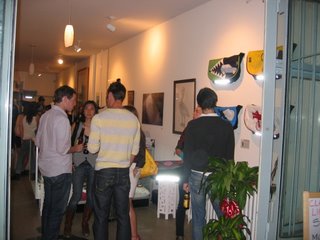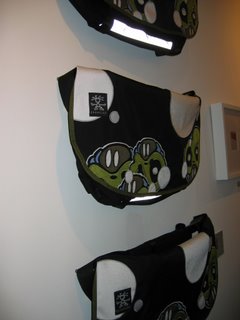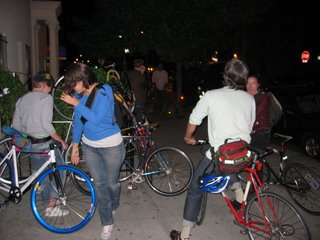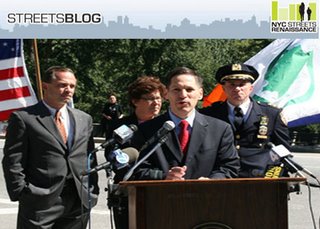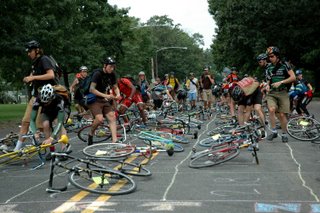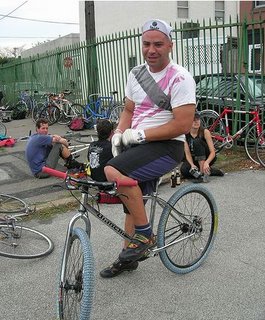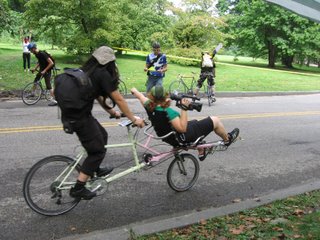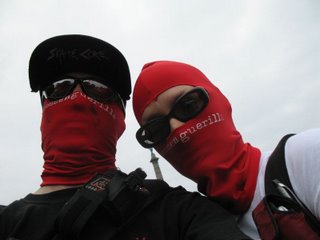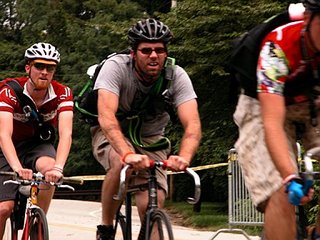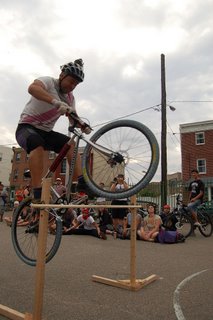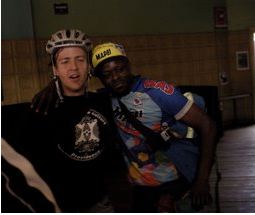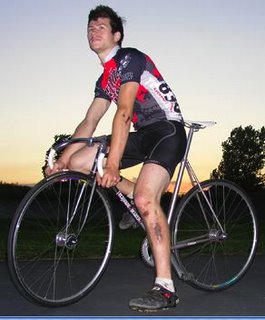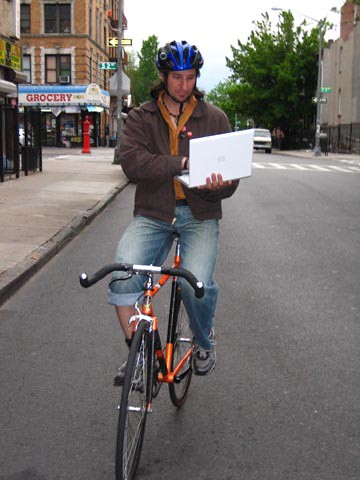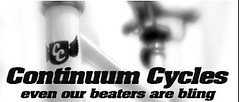There has been a lot of work by cyclists over the past months and NOT just from Transportation Alternatives...and it is starting to pay off. The city is taking notice of bikes and it shows in their recent planning. A huge article in the Sunday NY Times about biking, critical mass and a year of recent deaths at the hand of motor vehicles, has come out, talking about the recent history of the problem and connecting a few dots. This is a step in the right direction and some good press about all the hard work of cycling groups such as TA and Times Up, out there everyday riding there bike and being vocal about the kind of bike friendly city they deserve.
Link to article 
The City is home to about 120.000 regular cyclists, some of whom will attend a Critical Mass demonstration on Friday.
Quesy Rider
by Paul Kurutz
published in the New York Times-CIty Section-Sunday 24th, 2006
PAUL FORD, a soft-spoken, sturdily built 32-year-old who works as an editor at Harper’s Magazine, sometimes describes his commute between his apartment in Gowanus, Brooklyn, and his office on Broadway near Bond Street as feeling “like a video game, except you can get killed.” And in fact, watching Mr. Ford weave through the city’s traffic-clogged streets one recent morning, pedaling steadily atop his black and gray Fuji Sanibel cruiser, called to mind a two-wheeled, life-and-death version of the 80’s arcade game Frogger.
At 7:40 a.m., wearing jeans and a black T-shirt, Mr. Ford set out from his apartment near the Gowanus Canal and was soon moving briskly down Third Avenue in Boerum Hill. Mr. Ford is a physical presence on the road, a big guy atop a seven-speed bike, a shiny black helmet covering his short brown hair. But the motorists whizzing by pay him little mind.
Near Third Avenue and Douglass Street, he slowed and hugged the curb to avoid a delivery truck passing on his left. Pulling onto the street again, it was in the firm but cautious way a person might wade into a fast-moving river. Or, as Mr. Ford put it: “You’re fragile out here in traffic. Nothing bad comes from being paranoid.”
Mr. Ford is among an estimated 120,000 regular cyclists in New York, 40,000 of whom commute to work by bike. And increasingly, these cyclists are waging an ever more ferocious turf war with the city.
Like Mr. Ford, the majority of these commuters do daily battle on the city’s 6,000 miles of often jam-packed roadways. At the same time, a small number of cycling advocates lobby City Hall with almost religious fervor, seeking everything from more bike racks to legislation requiring office building owners to install storage space for bikes.
The most public lobbying efforts are the Critical Mass rides in Manhattan, consciousness-raising events that take place on the last Friday of every month — the next one is Friday — and resemble nothing so much as 1960’s political rallies. Before the most recent ride, a bleached-blond hipster preacher named Reverend Billy recited the First Amendment through a bullhorn. Later, police officers issued 65 moving violations and made one arrest.
Despite the obstacles, this may be an ideal moment for seeking a bike-friendlier New York. With issues like global warming and high gas prices at the forefront of public consciousness, many advocates say that after years of struggle, they finally have the political capital to make cycling a top priority in the city.
“This is absolutely a moment of opportunity,” said Walter Hook, executive director of the Institute for Transportation and Development Policy, a New York-based organization that designs mass transit in developing countries. “The mayor stood up and took a bold stance and banned smoking. The next step is to stop the air pollution coming out of the tailpipe.”
The Path Less Traveled
Mr. Ford had left home early, hoping to beat the morning rush, but five minutes into his commute, cars were already lined up bumper to bumper at a red light on Third Avenue. Knifing through traffic, he hung a left onto Bergen Street in Boerum Hill, where he could enjoy a sliver of comfort in the form of a five-foot-wide bike lane, designated by two painted white lines. A few cyclists overtook him, pedaling furiously on expensive-looking machines.
Mr. Ford began biking to work two months ago because he wanted to lose weight but didn’t feel like going to the gym. While his legs and lungs are stronger now, he by no means regards his ride as a test run for the Tour de France. “I’m just a chubby guy on a bike,” he joked as he made a right onto Smith Street and scooted across Atlantic Avenue.
New York is arguably the most challenging city in the country in which to ride a bike. The streets are crowded, the pace is furious and danger lurks everywhere, from crater-size potholes to car doors that snap open. When Mr. Ford began biking to his office, he was filled with the sense that he was an irrelevancy to motorists, a moving abstraction. Even now, he feels dangerously exposed. “Everyone is your enemy,” he said. “You don’t want to get killed, and you don’t want to kill anyone.”

Mr. Ford has yet to suffer any injuries on his daily commute, but he is fatalistic. “It’s only a matter of time until I have one of those near-death experiences that everyone who bikes in the city has had,” he said. According to the latest figures provided by the city, 109 cyclists were killed from 2000 through 2005. During the same period, there were 21,484 bicycle injuries recorded.
This June, in a grim reminder of the perils of urban cycling, three riders were killed in a three-week period. A 23-year-old aspiring filmmaker was pinned beneath a tractor-trailer on Houston Street in Manhattan on a weekday morning. A 41-year-old woman was hit by a truck on Rockaway Parkway in Brooklyn in the evening. And a 56-year-old doctor collided with a Police Department tow truck while taking a midnight ride on the Hudson River Greenway in Manhattan.
On June 29, in response to the deaths, about 75 cyclists staged a rally on the steps of City Hall. Standing in front of a “ghost bike” painted white to honor the fallen, Paul Steely White, executive director of Transportation Alternatives, the advocacy group that organized the rally, described the city’s streets as “out of control.” A week later, Andrew Vesselinovitch, resigned as director of the Bicycle Program of the city’s Department of Transportation after five years in the job, saying he planned to return to school. In leaving his position, he criticized the Department of Transportation for not making New York safer for cyclists and for creating less than 20 miles of new bike lanes in the past two years.
The numbers seemed all the more striking given the fact that Chicago, with a population of nearly three million, announced a plan this year to put every resident within a half-mile of a bike path. And Chicago’s program seems paltry in comparison with that of Davis, Calif., a city of 60,000 that Bicycling magazine said “has cycling in its veins.” Among Davis’s features are a $7.4 million bike tunnel and a network of bike paths so comprehensive and safe that the city has eliminated its public school buses.
Shifting Gears
As Mr. Ford pedaled along Jay Street, cut across a traffic tie-up at Tillary Street and squeezed precariously through a two-foot gap between a delivery truck and a concrete barrier to get onto the Manhattan Bridge, it was clear that orchestrating the flow of traffic is much more challenging in a city like New York than in a laid-back college town like Davis.
By some measures, New York is doing reasonably well for a large city. In May, a bike lane was built along Eighth Avenue in Manhattan, and, more significant, in 2001 the Hudson River Greenway, an 11.5-mile stretch that runs from Inwood to Battery Park City, was completed. With as many as 10,000 cyclists on the busiest days, Transportation Alternatives says, it ranks as the nation’s busiest bike path.
Two weeks ago, the Department of Transportation announced a plan to build 200 more miles of bike lanes over the next three years, at a cost of nearly $9 million. That would bring the city’s total to more than 600 miles.
The Parks Department also has several projects under way toward its long-term goal of a greenway all along the waterfront in the five boroughs. Bike paths beside every mile of Manhattan waterfront may be completed as soon as the end of 2008, according to Carli Smith, a department spokeswoman.
And this year, Bicycling magazine ranked New York the country’s third-best city for cycling among cities with population of more than one million, just behind San Diego and Chicago.
“New York is by no means a laggard,” said Andy Clarke, executive director of the League of American Bicyclists, a lobbying group in Washington that issues an annual list of what it calls Bicycle Friendly Communities. “New York is better than Los Angeles, and certainly better than Houston or Dallas.”
But many advocates say the city is making progress too slowly and is not fully committed to bicycling.
“We did 100 miles of bike paths and lanes in the past five years,” said Mr. Vesselinovitch, the former director of the Bicycle Program. “I think we could have doubled it. At D.O.T., we would support bicycling as long as it didn’t interfere with anything else.”
Iris Weinshall, the transportation commissioner, declined to respond specifically to Mr. Vesselinovitch’s comments. “I don’t want to look back,” she said. “I want to look forward.” She then said the city had made progress over the past five years; she cited the Manhattan Bridge bike lane, which was refurbished in 2001 and is used by an average of 840 riders a day.
As Mr. Ford made his way across that lane the other day, isolated from traffic and free to finally experience what he described as “a closer sense of the city,” he was enjoying the one truly peaceful moment of his commute. Halfway through his ride, his pace slackened. The morning air was crisp. The view from the bridge, which took in the entire East Side of Manhattan, was breathtaking. The moment was tempered only by a quarter-mile uphill grade, which left him breathing hard.
“With the subway,” Mr. Ford said, “you’re literally in a tunnel. When I bike, I see faces. I see storefronts. I’ll stop to visit someone. I’m engaged in the city.”
Imagining Bike Heaven
Up to this point, Mr. Ford’s ride had been a journey of extremes. He had passed through a leafy neighborhood of brownstones in Boerum Hill, plunged into the traffic-clogged heart of Downtown Brooklyn and been cosseted high above the East River. Now, with a light sheen of sweat on his face, he cruised off the bridge onto Canal Street into the pedestrian bustle of Chinatown.
The one constant of Mr. Ford’s ride was the persistent feeling that he was carving out a space for himself as a biker on streets where in many cases no such space existed. Except for the Manhattan Bridge, he hadn’t been on a bike lane since Bergen Street. If he were the city’s bike czar, he would change this.
“Cars are here to stay,” he said. “I don’t expect New York City to become bike utopia. But more share-the-road signs would be great, more bike lanes, more places to lock your bike.” All in all, “a little more room here and there.”
The city’s plan to add 200 miles of bike lanes would undoubtedly create much more room for cyclists like Mr. Ford. The new lanes, from Claremont Village in the Bronx to Downtown Brooklyn, would be a sort of interstate highway system for bikes throughout the five boroughs. Responding to safety concerns, the city is also installing five miles of protected lanes, in which riders are shielded from car traffic by barriers like concrete curbs.
But while cycling advocates have applauded the idea of protected lanes, their goals are far more ambitious.
“We’d like to see bike facilities on all the major arterials in the five boroughs, like Flatbush Avenue in Brooklyn and Houston Street,” said Mr. White, of Transportation Alternatives. “We’d also like to ban private vehicular traffic altogether on some streets.”
Mr. Hook, of the Institute for Transportation and Development Policy, heartily endorses the idea. “If you did something radical,’’ he said, “like taking Broadway out of the street grid and making it a greenway, not only would you create a north-south bike facility, but you would create a soul to the city and entirely change the feel of the place.”
When it was suggested that such a plan might produce havoc for Midtown drivers and stores relying on truck deliveries, Mr. Hook responded, “We could do what a hundred European cities do, which is allow trucks in during certain times of the day — say, between 8 and 10 a.m.”
But even more modest solutions far from Midtown can pit cyclists against nearly everybody else. That is the situation on Houston Street, which has become a prime point of contention between bike advocates and the Department of Transportation. The cyclists want a bike lane installed along Houston; the department, at least so far, has not concluded that this is a good idea.
In recent years, many cycling advocates have said that while the city officially supports biking, its decisions routinely favor drivers.
“When the city decides whether or not to put a bike lane on Houston Street, they think, ‘Well, we’re going to lose traffic volume,’ ” Mr. White said. “That’s the tradeoff that isn’t going our way, time and again.”
Ms. Weinshall, the transportation commissioner, would be the first to agree that the issue is complicated. “You have to parcel out the real estate to all of these different users,” she said. “Does it make sense to put a bike lane along Houston Street? Would we have to widen the sidewalks? These are things you consider. Bike riding is not made for everybody.”
The Home Stretch
Just a couple of minutes from the front door of his office, Mr. Ford was poised on Chrystie Street, considering a wide, loping left turn onto Houston Street that would deliver him into one of the busiest roadways in the city. “Two months ago I was terrified to make this turn,” he said as he merged with traffic and headed west on Houston toward Broadway. “But now it’s no big deal. You get used to it.”
Still, not everyone is so intrepid. Even if the necessary infrastructure like widespread bike lanes were in place, there would remain the question of how many New Yorkers would commute by bike, given practical concerns like safety, weather and health issues.
“I’ll bet not one person out of 20 would think to ride a bike to work,” said Kenneth T. Jackson, a professor of history at Columbia University who for years has led a bike ride around the city for his students. The ride takes place after midnight, the time Mr. Jackson most feels safe navigating around the city.
There is another issue, even apart from safety, that has to do with how biking in the city is perceived. “We take pride in our use of mass transit and the fact that we walk,” Professor Jackson said, “but somehow cycling doesn’t complete the trinity. It doesn’t seem normal.”
In addition, there is no consensus on whether an increase in cyclists would do much to help improve the city’s environment. City Councilman John Liu, of Flushing, Queens, chairman of the Council’s Transportation Committee, argues that subways and buses are the answer. “The use of cycles has a place,’’ Mr. Liu said. “But it doesn’t come anywhere near the capability of mass transit in making our city greener.”
For Mr. Ford, however, biking to work offers him a satisfaction that riding the subway or a bus does not. “There’s something great about getting to work under my own mode of power,” he said.
After making a right on Lafayette Street and a left on Bond, Mr. Ford was finally in the home stretch of his commute. He pulled up to the door of his office, dismounted and peeled off his helmet, sweaty but contented. “The hardest part of my day is already over,” he said. His four-mile commute had taken 32 minutes, about as long as it would have taken him on the R train.

